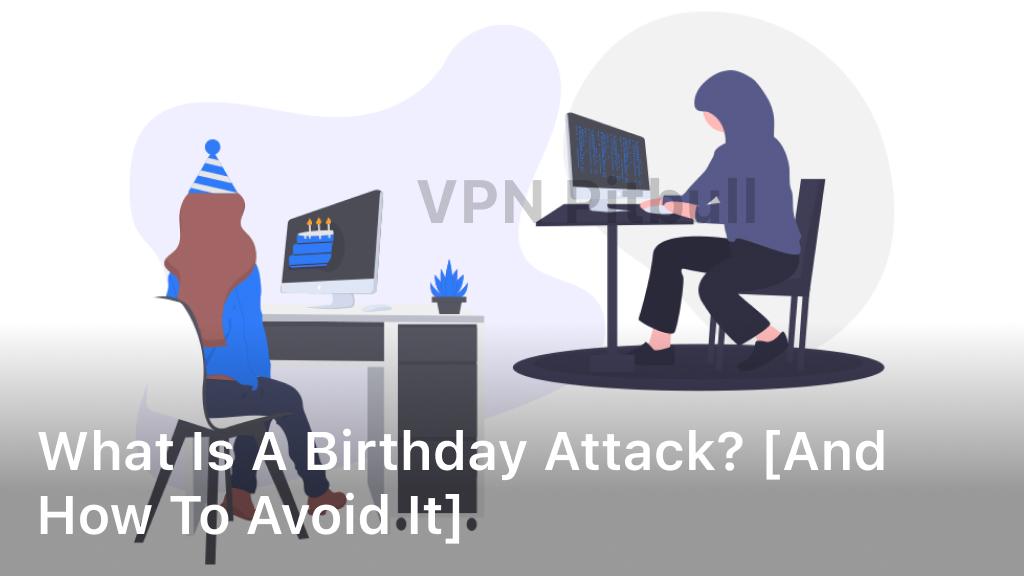What Is A Birthday Attack? [and How To Avoid It]
As cybersecurity threats continue to evolve rapidly, it becomes increasingly crucial to understand them. One such threat that is becoming increasingly common is the birthday attack, a type of cryptographic attack that exploits the probability theory behind birthday greetings.
A birthday attack can allow hackers to gain access to sensitive information, putting individuals and organizations at risk. In this article, we will explore what a birthday attack is, its vulnerabilities, and effective strategies you can implement to prevent falling victim to such attacks and safeguard your cybersecurity.

Understanding Birthday Attacks: A Closer Look
To truly comprehend the implications of a birthday attack, one must understand its inner workings. Birthday attacks are a type of cryptographic attack that leverage the birthday paradox – the probability that two people in a room of a certain size share the same birthday – to exploit a vulnerability in a cryptographic system.
Cryptographic birthday attacks come in various forms, including the birthday paradox attack, which exploits the probability of seeing a collision in a hash function, and the cryptographic birthday attack, which targets a particular cryptographic hash function.
Thus, understanding the different forms of birthday attacks and how they function is crucial to implementing effective cybersecurity measures.
Defining the Birthday Attack: Key Definitions
A birthday attack is a type of cryptographic attack that takes advantage of the high probability of collisions between the hashes of different inputs. The attack’s name originates from the birthday problem, which is a probability equation that calculates the likelihood of two individuals sharing the same birthday in a group.
In the context of cybersecurity, a birthday attack refers to a situation where an attacker tries to find two different inputs that, when hashed, result in the same value. This vulnerability means that an attacker could generate a fake message with the same hash as a legitimate one, allowing them to impersonate the sender or change the message’s contents without detection.
The birthday problem attack is a variant of the birthday attack that applies the same mathematical principle to brute-force attacks. It estimates the likelihood of finding collision points in a given hash function by calculating the necessary number of attempts.
Understanding these key definitions is crucial to identifying and preventing birthday attack vulnerabilities. By recognizing the probability concepts that underlie these attacks, individuals and organizations can adopt more effective cybersecurity measures and prevent potential security breaches.
Why Birthday Attacks Are a Security Concern
Birthday attacks have emerged as a significant cybersecurity threat, one that cannot be ignored. Hackers or malicious actors can exploit the birthday attack vulnerability to gain unauthorized access to sensitive data, systems or networks. This type of attack takes advantage of the probability theory used in cryptography to overcome cryptographic controls.
If left unaddressed, birthday attacks can have disastrous implications for both individuals and organizations. They can result in identity theft, financial loss, data breaches, and reputation damage. As such, it is of paramount importance that all potential vulnerabilities are addressed to prevent such attacks from occurring.
Prevention is key when it comes to securing against birthday attacks. One of the best ways to prevent them is to use strong cryptographic keys. Additionally, you can implement proactive measures such as regular security audits and assessments, strong password policies, and staying updated on potential threats. Remember, always remain vigilant and take the necessary measures to stay protected from these malicious attacks.
Strategies to Prevent Birthday Attacks
When it comes to preventing birthday attacks and enhancing your cybersecurity, there are several strategies you can implement. Here are some actionable tips and best practices:
- Use strong passwords: Strong passwords can make it harder for attackers to gain access to your systems or accounts. Make sure to use a mix of numbers, symbols, and upper and lowercase letters.
- Keep software and systems up to date: Outdated software and systems can have vulnerabilities that attackers can exploit. Make sure to install updates and patches as soon as they become available.
- Limit exposure of personal information: Attackers can use personal information to carry out targeted attacks. Be careful what personal information you share online and make sure to keep valuable information stored securely.
- Implement access controls: Limiting access to sensitive information can help prevent unauthorized access. Implement access controls, such as requiring user authentication and limiting privileges, to protect your systems and data.
- Use encryption: Encryption can help protect sensitive data from being intercepted or stolen. Use encryption for data at rest and in transit to reduce the risk of data breaches.
By implementing these strategies, you can reduce your risk of falling victim to birthday attacks and improve your overall cybersecurity.
Understanding the Birthday Paradox
As we’ve explored, birthday attacks can pose a real threat to cybersecurity, but how do they relate to the birthday paradox? Essentially, the birthday paradox attack exploits the fact that in a group of people, the probability of two people sharing a birthday is surprisingly high.
Understanding this probability concept is essential because it can help individuals and organizations strengthen their cybersecurity measures. By recognizing the weaknesses that could be exploited in a birthday paradox attack, one can take steps to prevent these attacks from happening.
Overall, understanding the birthday paradox and the underlying probability concepts is crucial to staying ahead of potential cybersecurity threats. By taking proactive measures and remaining vigilant, you can help protect yourself and your data from harm.
Strengthening Cybersecurity: Beyond Birthdays
While protecting against birthday attacks is crucial, it’s equally important to strengthen overall cybersecurity. Here are some additional preventive measures to consider:
- Use strong, unique passwords and multi-factor authentication
- Regularly update software and apps to the latest versions
- Be cautious when clicking on links or attachments from unknown sources
- Implement firewalls and antivirus software to protect against malware
- Train employees on cybersecurity best practices and awareness
By taking these measures, you can mitigate the risk of various cyber threats and ensure that your online presence and sensitive information are well-protected.
Conclusion
In today’s increasingly digital world, cybersecurity threats are becoming more prevalent, and birthday attacks are a growing concern. It is essential to understand the nature of such attacks and their potential risks to individuals and organizations alike.
Effective prevention strategies, as discussed in this article, are more important than ever. By implementing the recommended steps and best practices, we can significantly reduce the likelihood of falling victim to such attacks.
We cannot stress enough how crucial it is to prioritize cybersecurity and safeguard ourselves against potential threats. With the right preventive measures in place, we can enjoy the benefits of the digital age without compromising our security.
Ultimately, the best defense against cyber threats is knowledge, awareness, and vigilance. Birthday attacks may be a new concept for some, but it is an issue that requires our attention. As we continue to rely more on technology in our daily lives, let us remain informed, alert, and take the necessary steps to keep ourselves and our data safe.
FAQ
What is a birthday attack?
A birthday attack is a type of cryptographic attack that takes advantage of the birthday paradox to find collisions in hash functions. It involves finding two different inputs that produce the same hash output, potentially compromising the security of systems using hash functions.
How can I prevent a birthday attack?
To prevent a birthday attack, it is recommended to use cryptographic hash functions with a longer output size, such as SHA-256 or SHA-3, which make it computationally harder to find collisions. Additionally, regularly updating systems and implementing strong access control measures can further enhance protection against such attacks.
What is a cryptographic birthday attack?
A cryptographic birthday attack is a specific type of birthday attack that targets cryptographic systems using hash functions. By exploiting the birthday paradox, attackers attempt to find collisions in the hash outputs, which can have serious implications for the security of the system.
What is the birthday paradox attack?
The birthday paradox attack refers to a scenario where an attacker aims to find two different inputs that produce the same hash output by exploiting the mathematical concept behind the birthday paradox. This attack has implications for cryptographic systems relying on hash functions for integrity and security.
How does a birthday attack work?
A birthday attack works by taking advantage of the probability of finding collisions in hash functions. By generating a large number of random inputs and hashing them, the attacker looks for two inputs that produce the same hash output. This attack exploits the fact that the probability of collision increases as more inputs are hashed.
Why are birthday attacks a security concern?
Birthday attacks are a security concern because they can compromise the integrity and security of systems that rely on hash functions. Finding collisions in hash outputs can enable attackers to manipulate data, forge digital signatures, or bypass security measures, potentially leading to unauthorized access or data breaches.
What is the best way to strengthen cybersecurity and prevent birthday attacks?
Strengthening cybersecurity and preventing birthday attacks require a multi-faceted approach. Some effective strategies include regularly updating software and systems, implementing robust access controls and authentication mechanisms, using strong cryptographic algorithms and key management practices, and staying informed about the latest security vulnerabilities and best practices.
What is the significance of the birthday paradox in relation to birthday attacks?
The birthday paradox is a mathematical phenomenon that shows that in a relatively small group, the probability of two individuals sharing the same birthday is surprisingly high. This concept is utilized in birthday attacks, where attackers exploit the increased probability of finding collisions in hash functions as the number of hashed inputs grows.
How can I enhance my online security beyond protecting against birthday attacks?
Enhancing online security goes beyond protecting against birthday attacks. It involves implementing strong passwords and multi-factor authentication, regularly updating security software, being cautious of phishing attempts, using secure network connections, and educating oneself about common cyber threats and best practices for staying safe online.




